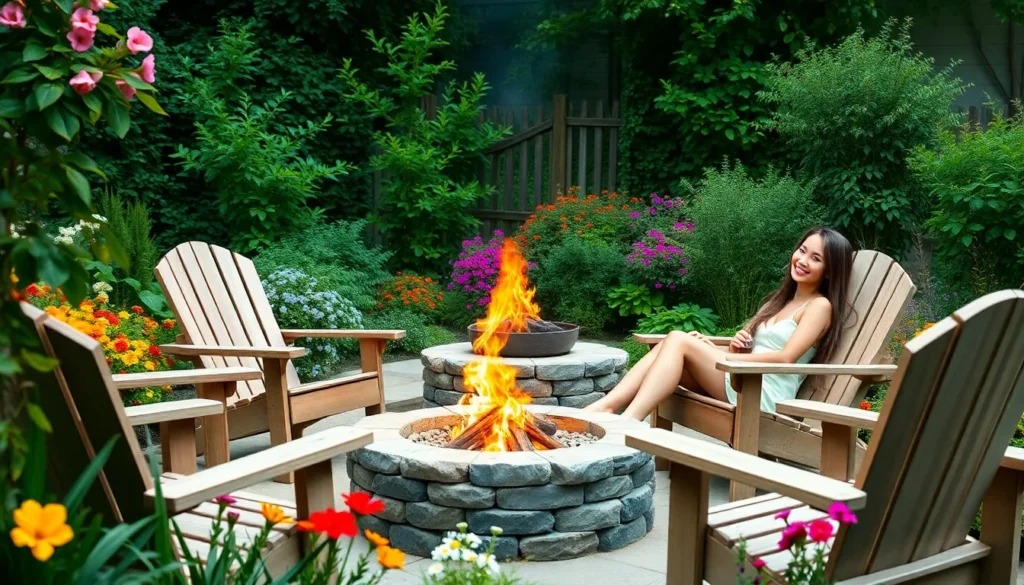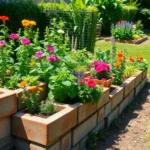We all know that feeling when we step into our garden and wish we had the perfect spot to unwind after a long day. Creating a dedicated sitting area transforms your outdoor space from just another yard into your personal sanctuary where you can sip morning coffee or host evening gatherings with friends and family.
Whether you’re working with a sprawling backyard or a cozy patio, we’ve discovered that the right seating arrangement can completely revolutionize how you experience your outdoor space. From rustic wooden benches nestled among flowering shrubs to modern fire pit lounges that extend your outdoor season, the possibilities are endless.
The best part? You don’t need a massive budget or professional landscaping skills to create a stunning garden retreat. With some creative planning and the right design ideas, we’ll show you how to build the perfect outdoor sitting area that reflects your style and meets your needs.
Create a Cozy Fire Pit Seating Area
Fire pit seating areas transform your garden into a year-round gathering spot that brings warmth and ambiance to any outdoor space. We’ll explore how to design the perfect fire pit zone that combines comfort with safety.
Choose the Right Fire Pit Style
Gas fire pits offer the convenience of instant flames with easy temperature control for busy homeowners. These modern options require minimal maintenance and eliminate the hassle of collecting firewood or cleaning ashes after each use.
Wood burning fire pits create that authentic crackling sound and smoky aroma that many people associate with traditional outdoor experiences. We recommend choosing fire pits made from steel, cast iron, or stone materials that can withstand regular use and weather exposure.
Portable fire bowls work perfectly for smaller spaces like patios or decks where permanent installations aren’t practical. These lightweight options typically range from 24 to 36 inches in diameter and can be moved to different locations as needed.
Built in fire pits become permanent industry features that increase your property value while creating a focal point for your garden design. Professional installation ensures proper ventilation and compliance with local fire safety regulations.
Arrange Seating in a Circle
Circular seating arrangements encourage conversation by allowing everyone to face each other naturally around the fire pit. We suggest positioning chairs or benches approximately 6 to 8 feet away from the fire pit edge to ensure comfortable heat levels and safety.
Adirondack chairs provide classic outdoor styling that complements rustic fire pit designs while offering excellent back support for extended sitting sessions. These wooden chairs work especially well when arranged in groups of four to six around medium sized fire pits.
Stone or concrete benches create permanent seating answers that require no maintenance and can accommodate multiple people per seat. We recommend adding cushions or outdoor pillows to hard surfaces for improved comfort during longer gatherings.
Mixed seating options like combining chairs with benches or ottomans give you flexibility to accommodate different group sizes throughout the seasons. This approach works particularly well for families who host both intimate gatherings and larger parties.
Add Weather Resistant Cushions
Outdoor fabric cushions made from solution dyed acrylic materials resist fading, mold, and moisture damage from seasonal weather changes. We’ve found that brands like Sunbrella and Outdura offer the best combination of durability and comfort for fire pit seating areas.
Quick dry foam inserts prevent cushions from staying soggy after rain showers or morning dew exposure. These specialized foam cores allow air circulation while maintaining their shape and support over multiple seasons of use.
Storage answers like waterproof deck boxes keep cushions clean and dry when not in use during harsh weather periods. We recommend choosing storage containers that match your outdoor decor while providing easy access for frequent cushion changes.
Color coordination between cushions and your existing garden elements creates a cohesive design that ties your fire pit area into the overall industry theme. Neutral colors like beige, gray, or navy blue work well with most outdoor furniture styles and won’t show dirt as quickly as lighter shades.
Design a Pergola-Covered Lounge Space

Creating a pergola-covered lounge brings elegant structure and natural shade to your garden sitting area. This design approach combines architectural beauty with functional comfort for year-round outdoor enjoyment.
Select Durable Pergola Materials
Cedar stands out as our top choice for pergola construction due to its natural weather resistance and beautiful grain patterns. We recommend cedar because it naturally repels insects and withstands harsh weather conditions without requiring frequent maintenance.
Redwood offers exceptional durability and naturally resists rot, making it another excellent material for pergola frames. This premium wood choice provides decades of structural integrity while developing an attractive silver-gray patina over time.
Pressure-treated pine delivers budget-friendly durability for homeowners seeking cost-effective pergola answers. We’ve found this treated lumber performs well in various climates while maintaining structural soundness for many years.
Install Comfortable Outdoor Furniture
Lounge chairs with weather-resistant cushions create the perfect foundation for relaxation in your pergola space. We suggest choosing furniture with aluminum or teak frames that won’t rust or deteriorate under your pergola’s partial coverage.
Outdoor sofas with plush cushions transform your pergola into an inviting conversation area for family and guests. These larger seating options work especially well when arranged in an L-shape or facing configuration.
Side tables and coffee tables add essential functionality to your pergola lounge by providing surfaces for drinks, books, and decorative elements. We recommend selecting tables that complement your seating while offering convenient storage options.
Add Climbing Plants for Natural Shade
Wisteria creates stunning overhead canopies with its cascading purple or white flower clusters that bloom in spring and early summer. This vigorous climber provides excellent shade coverage while adding dramatic visual appeal to your pergola structure.
Clematis vines offer diverse flowering options throughout the growing season, from early spring bloomers to late summer varieties. We love how these plants create natural privacy screens while producing colorful blooms in shades of purple, pink, white, and blue.
Grapevines serve dual purposes by providing leafy shade during summer months and potentially producing edible fruit for your table. These hardy climbers establish quickly and create dense overhead coverage that filters sunlight beautifully.
Build a Rustic Garden Bench Nook
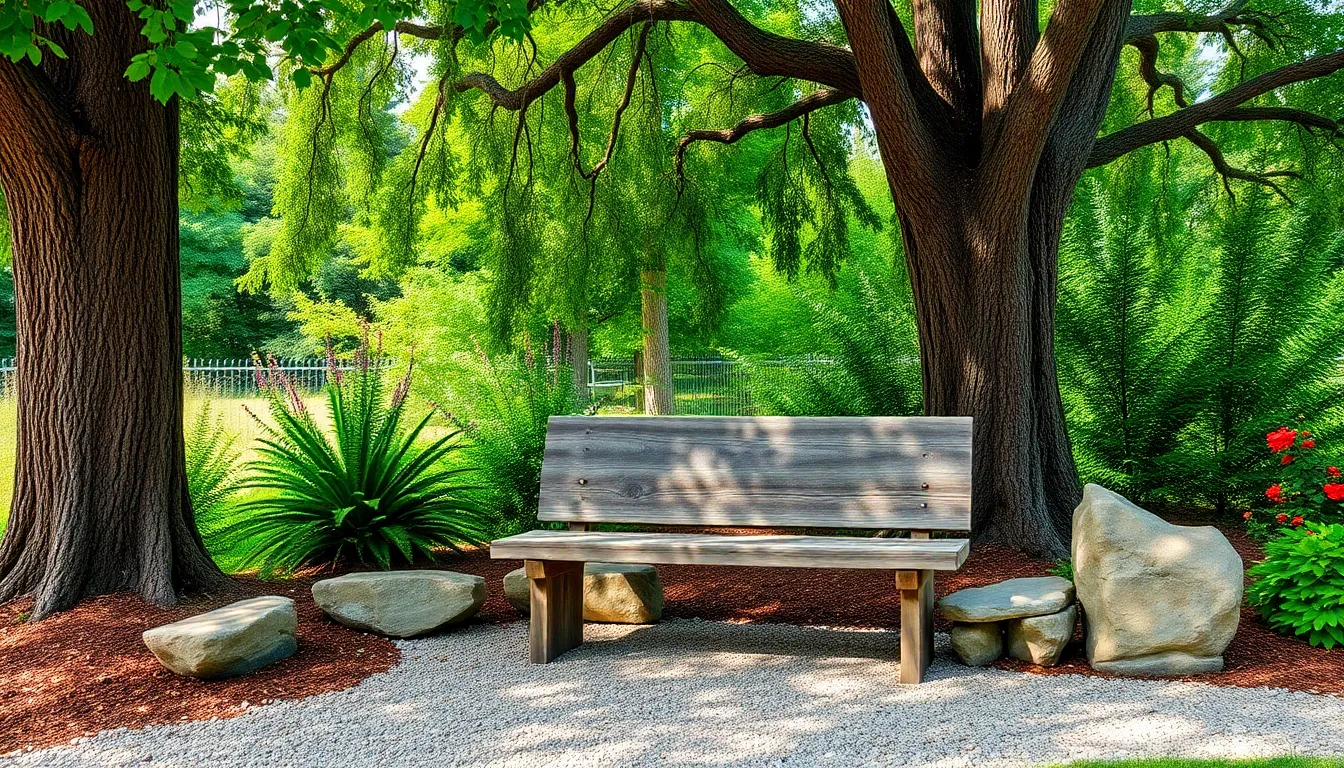
Creating a rustic garden bench nook transforms any corner of your outdoor space into a charming retreat that blends seamlessly with nature. We’ll guide you through the essential elements that make these intimate seating areas both functional and visually appealing.
Position Benches Around Trees
Positioning benches around mature trees creates an instant focal point while utilizing natural shade for comfortable relaxation. We recommend measuring the tree’s circumference to determine whether curved or straight benches work best for your space. Wood and stone materials blend harmoniously with garden environments and provide durability against weather conditions.
Installing tree benches encourages direct interaction with nature and offers a naturally cooled spot during warm weather. Consider the tree’s growth patterns when selecting bench placement to ensure long term functionality. Materials like cedar or teak complement the organic setting while requiring minimal maintenance over time.
Create a Gravel or Stone Pathway
Creating a gravel or stone pathway leading to your bench nook visually connects garden features while inviting visitors to explore the space. Gravel provides excellent drainage and requires minimal maintenance compared to other pathway materials. Natural stone offers superior durability and creates an elegant surface that withstands heavy foot traffic.
Shaping pathways to suit your garden’s size and style enhances the overall design cohesion of the seating area. We suggest flanking the pathway with low plantings or decorative edging to create a polished appearance. Both gravel and stone options can be customized to match your existing industry elements and personal aesthetic preferences.
Incorporate Natural Stone Elements
Incorporating natural stone elements adds permanent structure and rich texture to garden seating areas. Stone patios provide stable foundations for benches while low walls create defined boundaries around the nook. Decorative boulders serve as accent features that complement surrounding plantings and architectural elements.
Using stone for bench bases, pathway edging, or accent features creates visual continuity throughout the garden space. These permanent elements blend naturally with lush plantings and help establish clear boundaries for the seating area. Stone’s durability ensures your rustic nook maintains its appeal season after season while requiring minimal upkeep.
Establish a Dining Patio Area
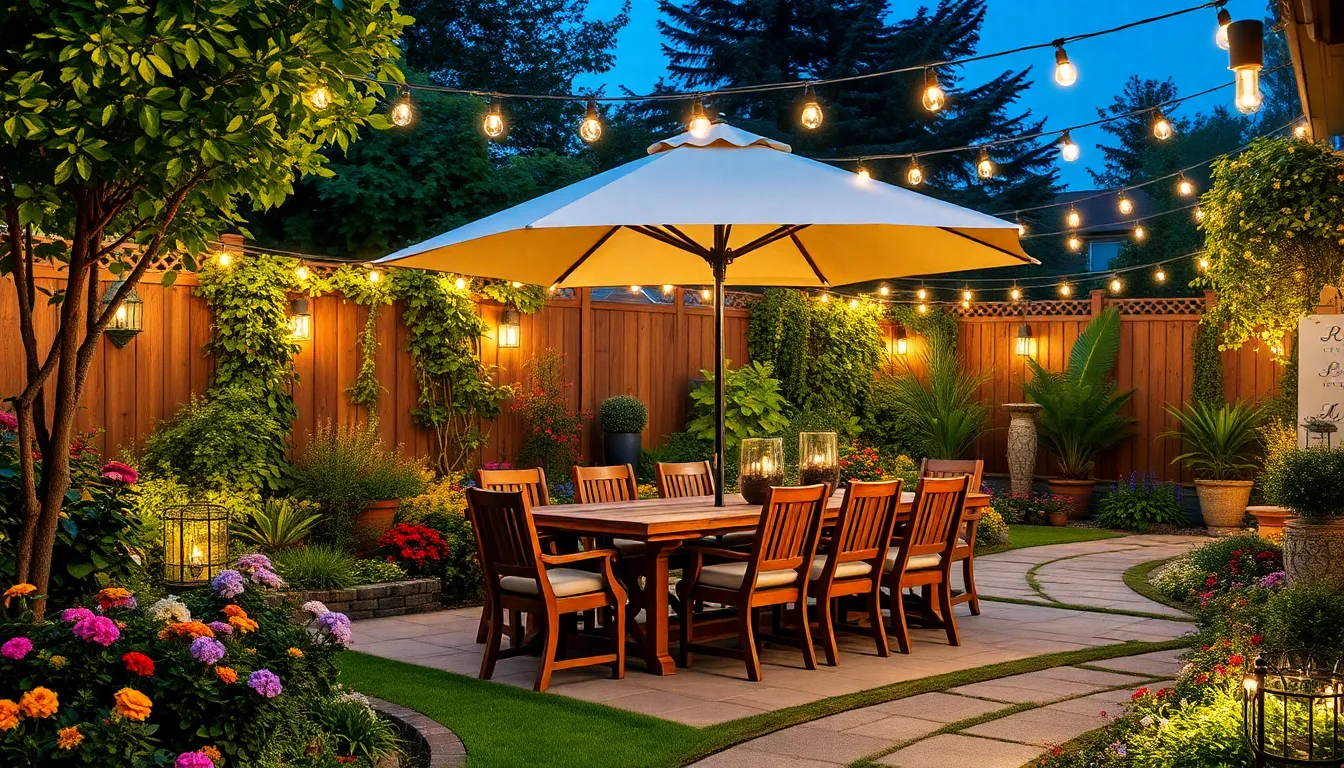
Creating a dedicated dining patio transforms your garden into an outdoor room where meals become memorable experiences. We’ll show you how to design boundaries using plants, fences, or trellises that frame your space while adding visual character and definition.
Choose Appropriate Table and Chair Sets
Sizing your furniture correctly ensures comfortable movement around the dining space without overwhelming the garden’s natural flow. We recommend measuring your patio area first, then selecting compact sets or benches for smaller spaces to maximize functionality. Materials like teak or aluminum provide durability while complementing various garden themes from modern to rustic styles.
Comfort becomes essential when you’re planning extended outdoor dining sessions with family and friends. Cushioned seating options with weather-resistant fabrics maintain their appeal throughout changing seasons. Style coordination between your table set and existing garden elements creates a cohesive outdoor dining experience that feels intentionally designed.
Install Proper Lighting Fixtures
Ambience lighting transforms your dining patio from a daytime space into an enchanting evening retreat perfect for dinner parties. String lights create warm, inviting atmospheres that encourage longer conversations over meals. Lanterns positioned strategically around the dining area add both functional illumination and decorative charm to your outdoor room.
Pathway lighting ensures safe navigation to and from your dining space during darker hours. We suggest installing low-voltage LED fixtures along walkways leading to your patio area. Safety considerations include adequate lighting over the dining table itself, allowing guests to see their meals clearly while maintaining the romantic outdoor ambiance.
Add an Outdoor Umbrella or Canopy
Shade provision makes your dining patio usable during intense midday sun when indoor alternatives might otherwise be necessary. Market umbrellas offer adjustable coverage that moves with the sun’s position throughout your dining experience. Cantilever umbrellas provide maximum table space without center pole interference during meal service.
Privacy enhancement comes naturally when you position umbrellas or pergolas strategically around your dining area’s perimeter. Vines growing over pergola structures create living canopies that develop character over time. Weather protection from unexpected rain showers ensures your outdoor dining plans aren’t completely derailed by sudden weather changes.
Construct a Raised Deck Retreat
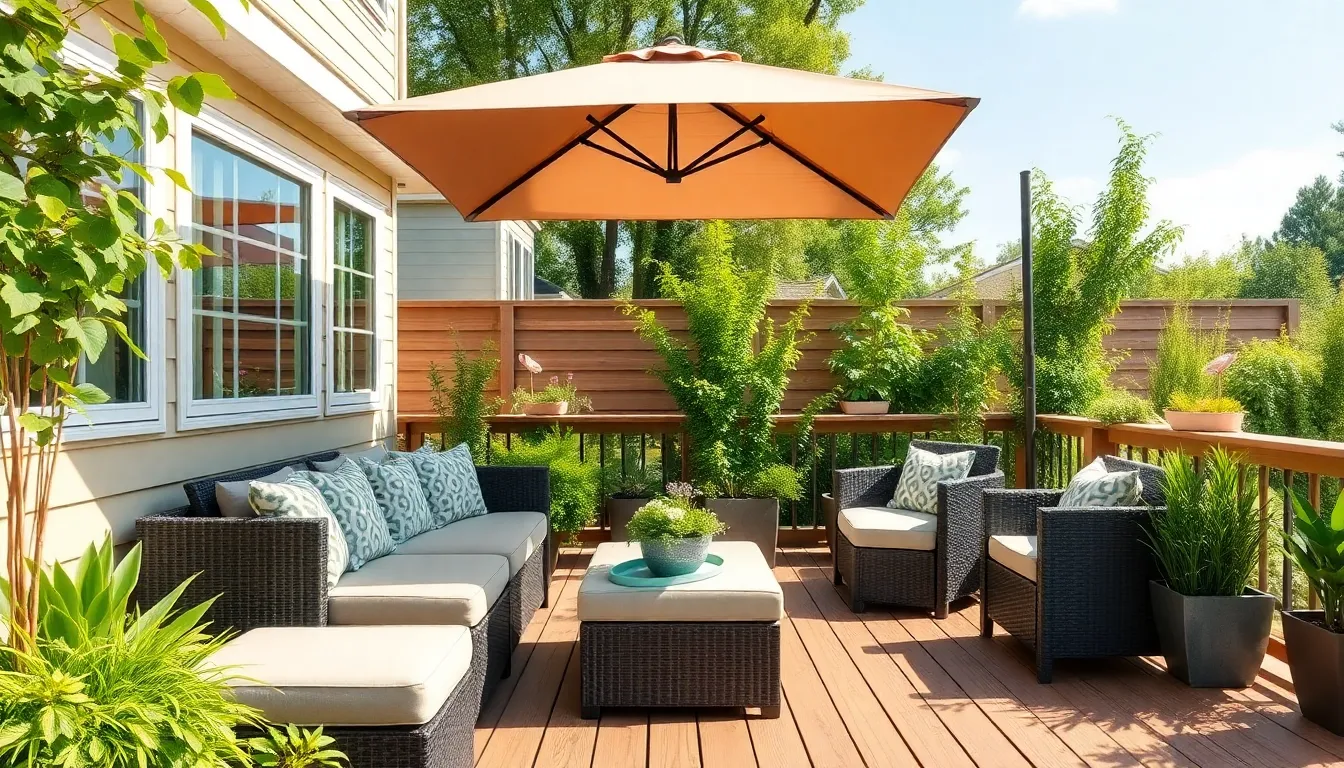
We can elevate our garden sitting area experience by building a raised deck retreat that provides an elegant platform for outdoor relaxation and entertaining.
Plan the Deck Size and Location
Location selection determines the success of our raised deck retreat by considering privacy, scenic views, and convenient access from our home. We should evaluate spots that offer natural screening from existing structures while maintaining visual connection to garden pathways and industry features.
Measuring the available space helps us determine appropriate deck dimensions that complement rather than overwhelm our outdoor area. Integration with nearby trees and shrubs creates a seamless transition between our deck retreat and the natural garden environment. We need to plot the deck’s exact footprint to ensure proper spacing around existing plantings and clear access routes.
Site accessibility influences both construction logistics and daily use patterns of our raised deck space. Strategic positioning allows us to connect the deck visually to other garden elements while maintaining functional separation from high traffic areas.
Select Low-Maintenance Decking Materials
Composite decking offers superior durability by resisting rot, warping, and insect damage while requiring minimal routine maintenance throughout its extended lifespan. These engineered materials maintain their appearance and structural integrity across various weather conditions without the constant upkeep demands of traditional wood options.
Pressure treated lumber provides a cost effective alternative that delivers reliable durability for budget conscious projects without sacrificing longevity. This treated wood option resists moisture damage and pest infiltration while offering the natural wood aesthetic many homeowners prefer.
| Material Type | Key Benefits | Maintenance Level |
|---|---|---|
| Composite Decking | Rot/warp/insect resistant | Minimal |
| Pressure-Treated Lumber | Cost-effective, durable | Low to moderate |
Material selection directly impacts both initial investment costs and long term maintenance requirements for our raised deck retreat. We can reduce ongoing upkeep expenses by choosing materials that naturally resist common outdoor deterioration factors.
Furnish With Multi-Functional Seating
Sectional furniture with weatherproof cushions maximizes seating capacity while providing flexible arrangement options for different entertaining scenarios. We can reconfigure modular pieces to accommodate intimate conversations or larger gatherings based on our exact needs.
Built in storage benches serve dual purposes by providing comfortable seating while concealing outdoor accessories, cushions, and entertaining supplies within easy reach. Foldable furniture options allow us to adjust our seating capacity seasonally and store pieces efficiently during harsh weather periods.
Shade structures like umbrellas or pergolas create comfortable microclimates above our seating areas while adding architectural interest to the deck design. Privacy elements such as planters and trellises establish soft boundaries around our retreat space while introducing vertical greenery that softens hard deck surfaces.
Boundary definition using existing fences, arbors, or strategically planted shrubs and trees creates a secluded atmosphere that enhances relaxation and intimacy. These natural screens provide wind protection and visual separation while contributing shade coverage that makes our deck retreat usable during peak sun hours.
Set Up a Hammock Garden Corner
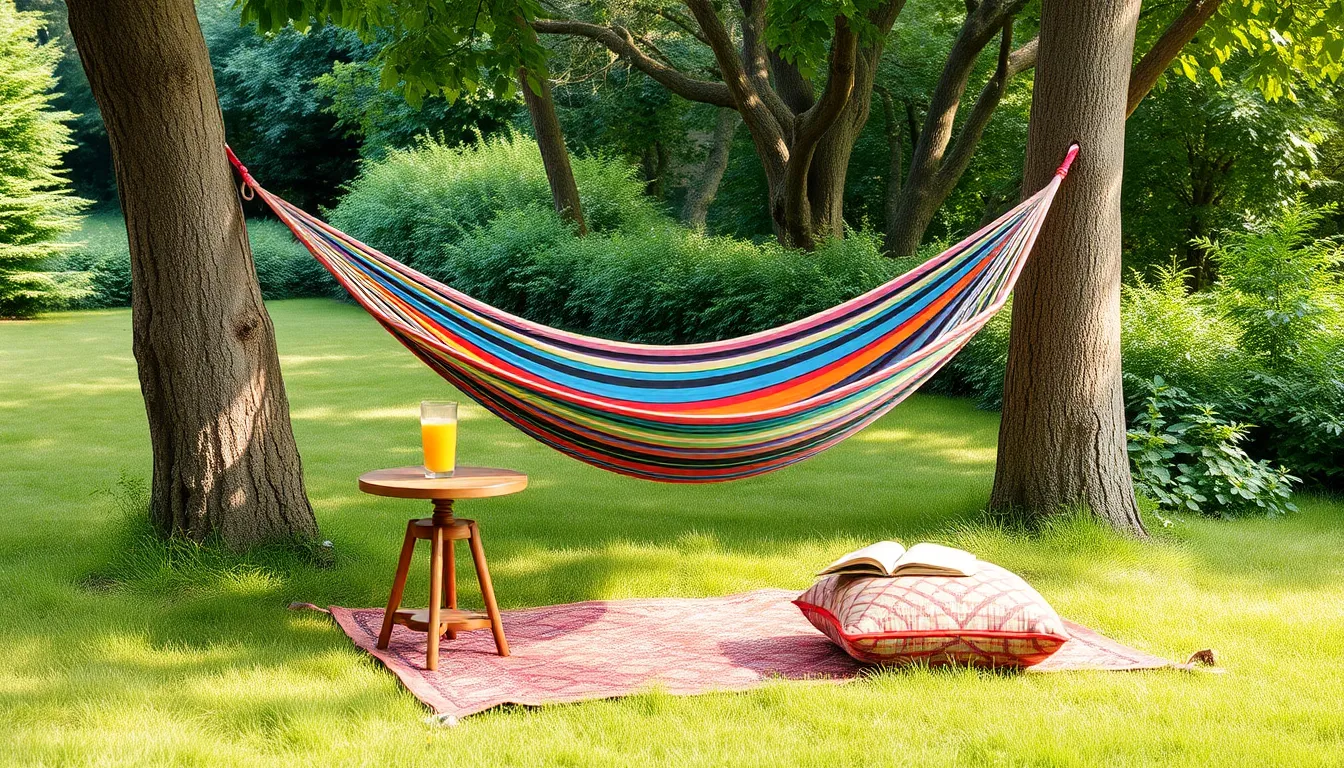
Hammocks transform any outdoor space into a tranquil retreat where you can sway gently while enjoying your garden’s natural beauty. This versatile seating option creates an instant relaxation zone that seamlessly blends comfort with your industry design.
Choose Between Trees or Stand Options
Trees provide the most natural and cost-effective hammock setup when you have two sturdy trees positioned 12-15 feet apart. Mature oaks, maples, or pine trees work best as anchor points since they can support up to 400 pounds without damage. Wrap tree straps around the trunks to protect the bark and prevent rope burn that could harm your trees over time.
Freestanding hammock stands offer complete flexibility in positioning your hammock anywhere in your garden. Steel stands provide the strongest support and can hold heavy-duty hammocks, while wooden stands blend beautifully with natural garden aesthetics. Portable options let you move your hammock to follow shade patterns throughout the day or relocate it seasonally.
Hybrid answers work well for challenging spaces where trees aren’t available or properly positioned. Combine one tree with a sturdy post or pergola beam to create the perfect hanging distance. This approach gives you natural ambiance while ensuring proper support and positioning.
Create a Soft Landing Area Below
Grass creates the most natural and comfortable surface underneath your hammock for those occasional tumbles or quick exits. Maintain the grass area with regular watering and fertilizing to keep it thick and cushioned. Overseed with soft grass varieties like fine fescue or perennial ryegrass for maximum comfort.
Mulch provides excellent shock absorption while requiring minimal maintenance compared to grass. Cedar mulch offers natural insect-repelling properties and creates a pleasant aroma, while rubber mulch provides superior cushioning and lasts longer than organic options. Apply a 3-4 inch layer for optimal safety and comfort.
Outdoor rugs add style and defined boundaries to your hammock area while providing a soft landing surface. Weather-resistant rugs made from polypropylene or recycled materials withstand moisture and UV exposure. Choose patterns that complement your garden’s color scheme and secure the corners with industry pins to prevent shifting.
Add Side Tables for Convenience
Small side tables keep essentials within arm’s reach without requiring you to leave your comfortable hammock position. Teak or cedar tables resist weather damage and complement the natural hammock aesthetic. Position tables at hammock height for easy access to drinks, books, or electronic devices.
Weatherproof storage stools serve dual purposes by providing surface space and hiding outdoor cushions or hammock accessories. Choose stools with lift-top lids to store items like sunscreen, reading materials, or light blankets. Wicker or resin stools blend seamlessly with garden furniture while offering practical storage answers.
Hanging organizers maximize convenience by attaching directly to hammock trees or stands. Mesh pockets hold smaller items like phones, keys, or snacks while keeping them protected from ground moisture. Install cup holders or bottle clips on nearby structures to prevent spills and keep beverages secure during gentle swaying.
Design a Water Feature Meditation Spot
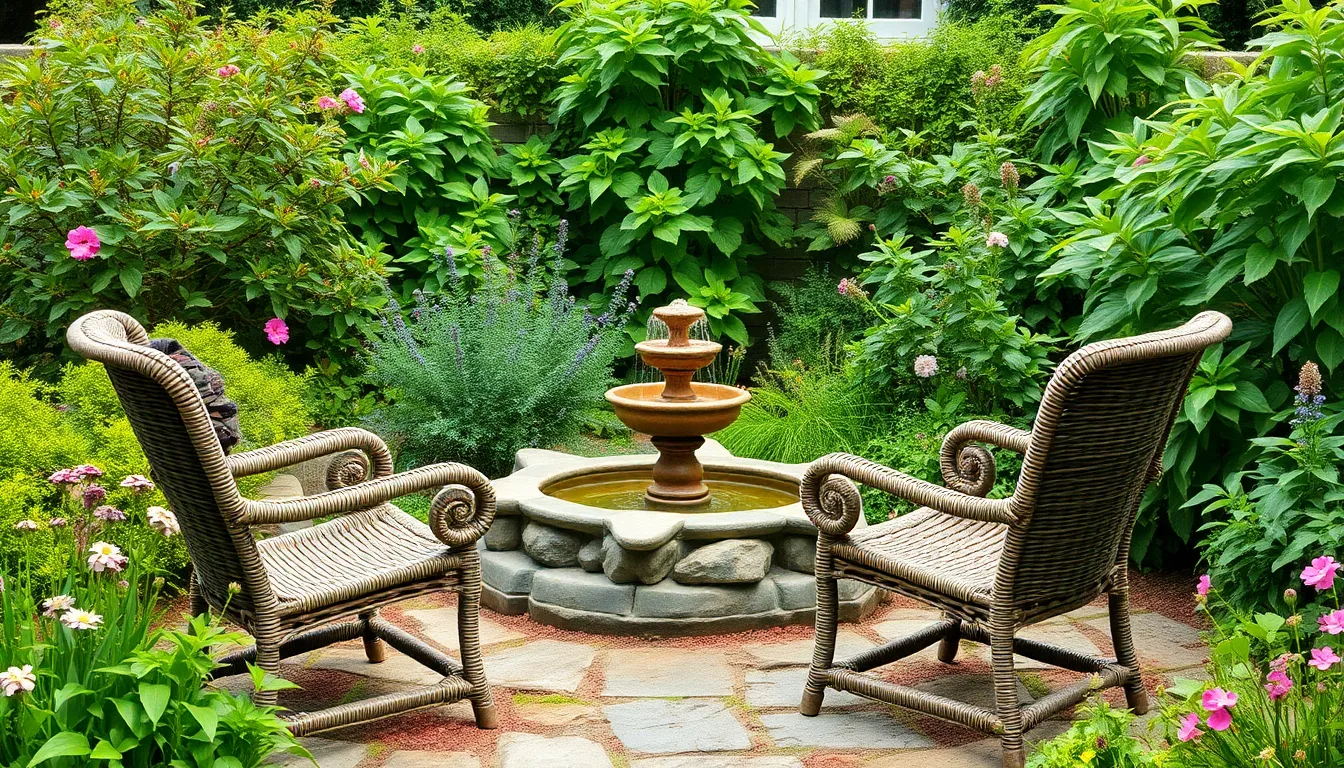
Water features transform ordinary garden spaces into tranquil sanctuaries where we can escape daily stress and reconnect with nature. Creating a dedicated meditation area around flowing water enhances our outdoor experience through soothing sounds and peaceful visuals.
Install a Small Fountain or Pond
Fountains provide the gentle sound of flowing water that naturally calms our minds and masks unwanted noise from nearby streets or neighbors. Small ponds create a reflective surface that adds visual depth to our garden sitting areas while supporting local wildlife like birds and beneficial insects.
Bubbling fountains work particularly well in compact spaces since they don’t require extensive excavation or complex plumbing systems. Installing a small waterfall feature enhances the calming effect by creating multiple water sounds and visual movement patterns.
Solar powered fountain pumps offer an eco friendly solution that eliminates the need for electrical connections in remote garden areas. Stone or ceramic fountain bowls blend naturally with existing industry materials while providing durability against weather changes.
Container water gardens using large pots or whiskey barrels create portable pond options that we can relocate seasonally or move indoors during harsh winters.
Position Seating to Face the Water
Seating arrangements directly impact how effectively we can enjoy and focus on our water feature during meditation sessions. Positioning benches or chairs to face the water encourages natural contemplation while maximizing the visual and auditory benefits of flowing water.
Wicker chairs provide comfortable seating that withstands outdoor conditions while maintaining an organic appearance that complements water features. Curved bench designs create intimate seating areas that naturally guide our attention toward the central water element.
Distance matters when placing seating around water features since sitting too close can create splashing issues while positioning chairs too far reduces the calming audio effects. We recommend placing primary seating 3 to 5 feet away from fountain edges to achieve optimal sound levels without water spray concerns.
Multiple seating options at varying distances accommodate different preferences and group sizes during meditation or quiet reflection time.
Plant Calming Herbs and Flowers Nearby
Strategic plant selection around meditation seating enhances the sensory experience through natural aromatherapy and visual beauty. Lavender releases its signature scent when brushed against or warmed by sunlight, creating an instantly recognizable relaxation trigger.
Chamomile produces small daisy like flowers that add gentle color while providing natural stress relief properties when the leaves are lightly crushed. Roses contribute classic beauty and natural fragrance that varies throughout blooming seasons.
Jasmine vines can climb nearby trellises or pergola structures, releasing intense evening fragrances that enhance twilight meditation sessions. These climbing plants also provide natural privacy screening around intimate seating areas.
Herbs like mint, lemon balm, and sage offer both aromatic benefits and practical uses since we can harvest leaves for teas or cooking projects. Grouping plants by height creates layered visual interest while ensuring shorter varieties aren’t overshadowed by taller specimens.
Native plants require less water and maintenance while attracting local butterflies and beneficial insects that add gentle movement and life to our meditation space.
Create a Swing Seat Haven
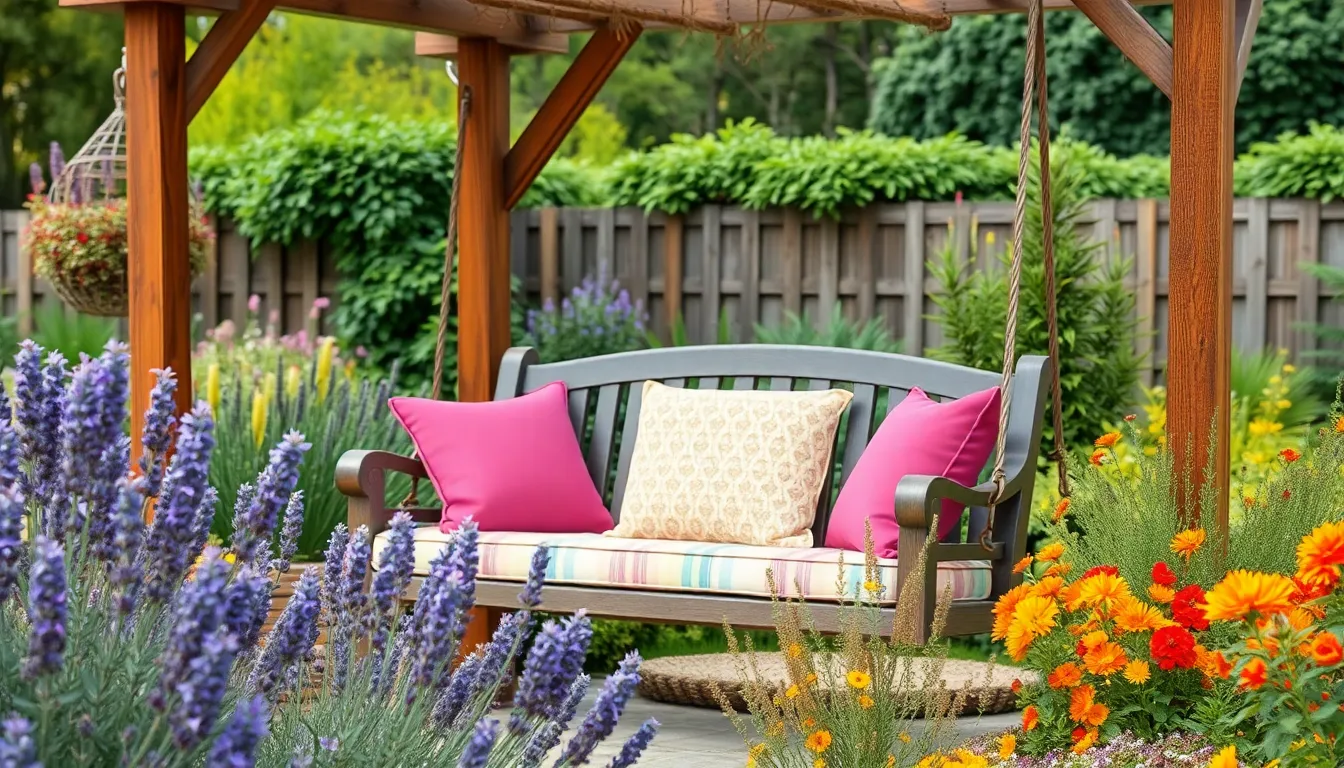
Building on our garden seating journey, we’ll explore how swing seats can transform your outdoor space into a gentle retreat. Swinging motions naturally promote relaxation and create an enchanting focal point that complements other garden features like fire pits and pergola lounges.
Install a Sturdy Tree Swing or Frame
Installing your swing seat properly ensures both safety and longevity in your garden sanctuary. We recommend using mature trees with branches at least 8 inches in diameter for tree-mounted swings, as these provide the necessary support for regular use. Positioning the swing 24 inches away from the tree trunk prevents damage to bark and allows comfortable swinging motion.
Freestanding frames offer excellent alternatives when suitable trees aren’t available in your desired location. Metal A-frame structures typically support 400-500 pounds and integrate seamlessly with existing garden elements like stone pathways or raised deck areas. Cedar or pressure-treated lumber frames provide rustic charm while withstanding weather conditions similar to pergola materials.
Securing hardware requires galvanized bolts and chains rated for outdoor use to prevent rust and ensure durability. We suggest checking all connections monthly during peak usage seasons to maintain safety standards and extend your swing’s lifespan.
Add Colorful Outdoor Pillows
Adding vibrant pillows transforms basic swing seats into inviting comfort zones that beckon relaxation. Weather-resistant fabrics like solution-dyed acrylic or marine-grade vinyl maintain their appearance through seasons while providing the cushioning needed for extended lounging sessions. These materials resist fading and moisture damage, ensuring your investment remains beautiful year after year.
Color coordination with existing garden elements creates visual harmony throughout your outdoor space. Bright coral pillows complement stone garden features, while deep blues enhance wooden deck settings and neutral tones blend naturally with rustic bench areas. We recommend choosing 2-3 coordinating colors rather than mixing too many patterns for a cohesive design.
Storage answers protect pillows during harsh weather and extend their useful life. Waterproof storage boxes positioned near swing areas provide convenient access while maintaining the organized appearance of your garden seating zones.
Surround With Fragrant Garden Plants
Surrounding swing seats with aromatic plants creates multi-sensory experiences that enhance relaxation and meditation benefits. Lavender planted 3-4 feet from seating areas releases calming scents without overwhelming the space, while its purple blooms add visual interest during growing seasons. These plantings work beautifully alongside water feature installations or rustic garden corners.
Rosemary and jasmine provide year-round fragrance options that complement different garden styles and seasonal changes. Night-blooming jasmine creates magical evening experiences when combined with string lighting or lantern installations around swing areas. We suggest grouping fragrant plants in odd numbers for natural-looking arrangements.
Strategic placement prevents plants from interfering with swing motion while maximizing scent benefits. Positioning taller plants like rosemary bushes behind seating creates natural privacy screens, while lower-growing herbs like thyme can border pathway approaches to your swing haven.
Conclusion
We’ve explored countless ways to transform your garden into the perfect outdoor sanctuary. Whether you’re drawn to the warmth of a fire pit gathering space or the tranquil charm of a hammock corner each idea offers unique benefits for your lifestyle and budget.
Remember that the best garden sitting area is one that reflects your personal style and meets your exact needs. You don’t need to carry out every concept – choose the elements that speak to you and create a space where you’ll actually want to spend time.
Start with one focal point and build from there. Your outdoor retreat awaits and with these ideas you’re well-equipped to create a garden sitting area that’ll become your favorite spot for years to come.
Frequently Asked Questions
What are the key elements needed to create a cozy fire pit seating area?
A cozy fire pit area requires a suitable fire pit (gas, wood-burning, or portable), weather-resistant seating arranged in a circle, and comfortable cushions made from outdoor fabrics. Consider adding Adirondack chairs, stone benches, or mixed seating options. Ensure proper spacing for safety and conversation flow, with adequate clearance from structures and vegetation.
Which materials are best for building a pergola-covered lounge space?
Cedar is ideal for its natural weather resistance, redwood offers excellent rot resistance, and pressure-treated pine provides a budget-friendly option. All materials should be properly sealed and maintained. Pair with weather-resistant outdoor furniture, lounge chairs with waterproof cushions, and consider adding climbing plants like wisteria or clematis for natural shade.
How do I choose the right location for a raised deck retreat?
Consider privacy levels, scenic views, and accessibility from your home. Measure available space to determine appropriate dimensions and integrate with existing trees and shrubs for seamless garden transition. Ensure proper drainage, level ground, and compliance with local building codes. Factor in sun exposure and prevailing winds for optimal comfort.
What’s the difference between composite and pressure-treated lumber for decking?
Composite decking offers superior durability, low maintenance, and resistance to fading, staining, and insects, but costs more upfront. Pressure-treated lumber is more affordable and readily available but requires regular maintenance, staining, and replacement over time. Both options provide solid foundations for outdoor living spaces.
How can I create a functional hammock garden corner in a small space?
Use freestanding hammock stands if trees aren’t available, and position over soft surfaces like grass or outdoor rugs. Add compact side tables for essentials and consider wall-mounted storage solutions. Choose a spot with partial shade and good drainage. Portable or compact hammock designs work best for smaller gardens.
What seating arrangements work best for outdoor dining patios?
Size your table and chairs to allow 3-4 feet of movement space around the dining area. Choose durable materials like teak or powder-coated aluminum that withstand weather. Add cushioned seating for comfort during extended meals, and ensure style coordination throughout the space for a cohesive outdoor dining experience.
How do I incorporate proper lighting for evening outdoor entertaining?
Install string lights for ambient lighting and pathway safety. Add lanterns or solar-powered fixtures for functional illumination without electrical work. Consider uplighting for trees and architectural features. Layer different light sources at varying heights to create depth and warmth while ensuring adequate visibility for dining and socializing.
What plants work best around pergola structures for natural shade?
Wisteria provides beautiful spring blooms and dense coverage, clematis offers colorful flowers with moderate growth, and grapevines create edible harvests plus excellent shade. Choose climbing plants based on your climate zone, desired coverage speed, and maintenance preferences. Ensure proper support structures for heavier vines.

